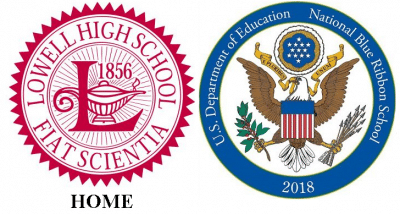Lowell High School traces its beginnings to 1856 when the San Francisco School Board established the first public secondary school in California. It was called Union Grammar School, but was officially changed to San Francisco High School in 1858. Six years later the girls were sent to another school and the name was changed to Boys’ High. In 1876, the school moved into a new three-story structure on Sutter Street between Gough and Octavia. In the 1890s, girls once more began to attend to take such college prep courses as Latin and Greek. In 1894, the school was renamed to honor the distinguished poet, James Russell Lowell.
School Departments
In the 1890s, the school was organized into three departments: Classical, Latin/Scientific and English. During this period the school started to look upon college preparation as one of its principal functions. More and more of the students who entered had a college degree as their ultimate goal .
Earthquake and Fire
In April 1906, the history of Lowell almost came to an end when the city was rocked by the earthquake followed by the fire that destroyed a large portion of San Francisco. Fortunately, the fire was halted at Van Ness Avenue, and the school escaped the flames. After 1900, the Sutter Street Building became over-crowded and a campaign for a new site was started. In 1908, a bond issue was placed before the public, and funds were made available for a new school.
It opened its doors in January 1913, on an entire city block on Hayes Street between Ashbury and Masonic. Lowell was to remain there until l962, a half century during which Lowell’s position as the city’s college preparatory high school was firmly established. Many of the present Lowell staff remember pleasant years of teaching at the Old Lowell.
The school had hardly finished celebrating its tenth anniversary at the new location when the first cries for a “new Lowell” were raised. It was generally agreed that the site was not adequate to perform properly the functions of a modern high school. The auditorium accommodated barely 25% of the student body; it had no library and no room for the construction of an athletic plant.
In 1952, the drive accelerated for a new Lowell on District property near Lake Merced. A petition containing thousands of signatures was presented to the School Board asking for the site for a school that would be a four-year, non-districted academic institution. In 1955 the Committee for a New Lowell expanded into the Centennial Committee to make plans for celebrating the school’s one- hundredth birthday, along with keeping the movement for a new building a live issue.
Events celebrating the centennial were scheduled throughout the entire 1956 school year. Highlights included an Alumni Centennial Banquet and Ball at the Fairmont Hotel attended by 1,200 graduates, Homecoming Day and Open House for the Poly game, and the publishing of a Centennial Yearbook. During this year the “Save Lowell” committee won from the Board a commitment that the new Southwest high school would bear the name Lowell. In a ceremony at the Lakeshore site, the mayor laid the cornerstone of the new building.
Five Million Dollar Plant
Lowell opened its new five million dollar plant in 1962 to complete the fourth move in its history. At the time of the move, opponents of the concept of an academic high school in San Francisco attempted to convince the Board that such a school was detrimental to public education in the city. In a historic decision before more than 1,000 people gathered in Nourse auditorium, the Board voted 6 to 1 to maintain Lowell in its new building as a strictly academic, non-districted high school. However, it was to lose its ninth grade and become a three-year high school.
In 1966, because of the limited capacity of the school (2,200-2,300), it became necessary to limit enrollment. An admissions committee was formed consisting of district administrators and members of the Lowell staff. Students from the junior high schools or transfers from other schools had to meet a GPA requirement in academic subjects in order to be admitted. (A student’s CTBS scores were added to the admissions criteria in 1980.)
In 1968, Lowell’s administrators and staff began a two-year project aimed at making greater use of the human and physical resources at the school, and increasing participation in both the curricular and co-curricular programs. The result was the “Lowell Plan,” later given the title “Project On-Site” a reorganization that changed the traditional seven-period day to the modified modular schedule still in effect today. (A full description of the plan is available in the Meyer Library.)
Lawsuit against the San Francisco Unified School District
In September 1971, the Youth Law Center filed a suit against the San Francisco Unified School District alleging that by maintaining a city-wide, non-districted academic high school, admission to which is based on academic standards, the school district discriminates against several categories of students and that such discrimination is unconstitutional. After prolonged hearings in the spring and summer of 1972, a judge of the Federal District Court issued a summary judgment that the constitutional rights of the complainants had not been violated.
The legal decisions that emanated from the suit validated the affirmative action component of the admission policy and mandated identical admission requirements for female and male students. The early seventies found the school a senior high school with a rich academic program. Two major events were to dominate the second half of the decade; the restoration of the ninth grade and the changes in funding for public schools that followed the 1978 Jarvis-Gann initiatives (Proposition 13).
The staff welcomed the ninth grade, but found the school crowded with an additional 700 freshmen to go with the other three classes of 900 each. A “south campus” located at San Francisco State University was needed while the staff completed the transition to four classes of approximately 700 each. The financial problems were less amenable to solution. Among the results were loss of staff, larger class size, loss of electives and two devastating strikes. The staff’s and faculty’s intensive efforts were necessary to save the elements of the Lowell Plan and the quality of the program.
The decade of the ’80s was a time of recognition for Lowell. In turn, Money, Parade and Town and Country included Lowell as one of the best public schools in the nation. The State of California twice recognized the school for excellence. The United States Department of Education honored the school in the first group of excellent schools in the 1982-83 school year. In 1986 the University of California at Berkeley hosted a Lowell Day in recognition of the long partnership of the two schools.
The eighties saw the PTSA and Alumni Association grow in strength as they undertook to bring a measure of financial support to the school. One of the tangible results of the PTSA’s efforts was the construction of the library addition. The Alumni Association staffs a campus office and the PTSA and other volunteers staff the student bookstore and the VICCI College Counseling Center.
In the mid-eighties, a new state law, SB 813, presented a challenge to the Lowell Plan and the unique way in which the school provides time for students to utilize the resources of the school. Subsequent to long discussions with the State Department of Education, resource center time was construed as instructional time to be included in the 64,800 minutes of incentive time, a validation of the Lowell Plan. Other validations of the Lowell program are the success of the Advanced Placement program and the school’s standing as first or second in the California Assessment Program between 1985 and 1990.
Lowell Retreat
In the fall of 1993, the PTSA sponsored a highly successful “Lowell Retreat” in which almost 100 parents, administrators, teachers, students, and alumni spent a weekend discussing Lowell’s past, and deliberating on its present and future direction. A series of recommendations was generated and several committees were created to formulate follow-up action plans that tied directly to the WASC Self-Study.
Shortly after the WASC Accreditation Committee departed in April 1994, Lowell was chosen a California Distinguished School by the state Department of Education. This was the fourth time that Lowell was accorded this honor, having previously been recognized in 1986, 1990 and 1992 (“Sustained Achievement” category).
But topping many other achievements in 1995 was the unbelievable triumph of the Lowell Varsity Football Team at the “Turkey Day Game” at Kezar Stadium. This was not the usual football win, but a come-from-behind thriller executed against the physically-superior Galileo High School team, the defending city champs. With spectacular plays and using “brains and brawn” (as noted by a newspaper writer) at the right moments, the amazing quarterback and his teammates gave Lowell its first city football championship in 18 years.
Lowell High School Accomplishments
1996 was also a momentous year in which many local, state, and national honors and awards were bestowed on the Lowell community to acknowledge the outstanding accomplishments of its stakeholders. In particular, the U.S. Department of Education’s May 1996 Blue Ribbon Award validated our cooperative and collaborative efforts that have continued unabated to advance educational excellence for Lowell students at all grade levels. Lowell representatives attended a White House ceremony honoring the award recipients from all regions of the nation.
Throughout the mid-nineties, the PTSA’s efforts continued to complement the generous contributions made by individual alumni and by a supportive Alumni Association that gave grants directly to teachers. Most notable among those alumni was William R. Hewlett who responded in October 1996 to a request for assistance by donating to Lowell $280,000 in computer equipment for a new computer lab. This was Mr. Hewlett’s third major donation in eight years.
In November 1996, the College Board ranked Lowell sixth nationally among over 10,800 high schools in terms of the number of Advanced Placement (AP) examinations administered in May 1996 to students in the AP Program (626 students took 1,339 exams). Lowell was ranked eighth in 1994. The higher ranking in 1996 reflected the growth in the popularity of the AP Program and the superior caliber of instruction provided by our AP teachers.
At the end of January 1997 Lowell received five more temporary bungalows that were installed in the west parking lot. These bungalows helped to relieve the classroom shortage, reduced the number of teachers having to travel from room to room, and freed the resource centers for 100% usage by students.
To address our facilities needs on a permanent basis district Superintendent Waldemar Rojas recommended that Lowell be included in the $140 million bond measure for “Educational Building Improvement” proposed for placement on the June 1997 election ballot. The improvement proposal for Lowell called for the demolition of all dilapidated bungalows and the construction of a new science/academic wing at an estimated cost of $7 million:
“The new science/academic wing will be designed as a two-story structure with 24 state of the art classrooms for science and liberal arts studies. Also included in this new structure will be support spaces such as lab storage, kiln yards, outdoor studios, art storage, staff offices, student study areas, and restrooms. The addition of this new science/academic wing will be in keeping with the exceptional academic standards of the Lowell campus and be a prototype for future academic classroom environments.” (SFUSD Project Description, November 18, 1996)
In addition to the Proposition A bond measure, which passed, Lowell was allocated $553,000 in spring 1997 to upgrade existing science labs and implement other site/safety improvements.
Strategies for Success
In 1996, in an effort to raise student performance standards, the district provided additional teachers to teach a 7th class for all 9th graders in every high school. At Lowell, the district also allocated three “above-formula” teachers to teach “Strategies for Success” classes in the 9th grade “value-added” support program. Furthermore, five paraprofessionals were hired to staff the resource centers which were made available to all students who needed academic remediation and/or enrichment.
The allocation of additional staffing and the establishment of resource centers emanated from a dramatic change made by the Superintendent and School Board in the Lowell admissions policy during 1995-96. The new admissions policy prescribed that 80% of the freshmen (regardless of their racial/ethnic background) are to be admitted under one cut-off score computed strictly according to their composite score which is based on their middle school GPA and CTBS percentile ranking. The remaining 20% of the freshmen are selected from a pool of “value-added” applicants, who are given extra points if they produce evidence that meets additional criteria, e.g., took honors courses in middle school, lived in public housing, were eligible for the federal lunch program, participated in extracurricular activities, had parents who did not graduate from high school, etc. Students in this 20% group are required to attend a summer school “Bridging Program” and take a “Strategies for Success” class during the regular school year. Due to the underrepresentation of students of African American, Latino, and American Indian descent, the school has continued to make special efforts to recruit and encourage students from these communities to attend Lowell.
The Site Advisory Council (SAC) evolved from a WASC recommendation into a living reality. Using the principal’s March 1992 concept paper on the formation of an SAC and ideas generated from the faculty, parents and students during the WASC self-study process of 1993-94, Lowell was able to create a functioning SAC in the fall of 1994. The SAC is composed of 26 voting members representing all the constituent groups in the Lowell community–faculty, administration, students, parents, classified staff, alumni, and the residential/business community. In its developmental phase, the SAC met weekly to discuss its purpose and define its role and responsibilities. Eventually, a constitution and by-laws of the “Lowell Site Advisory Council” were drawn up and adopted in March 1995. Since that time, the SAC has met twice a month during the school year to carry out its myriad functions.
In spring 1997, membership in the SAC was modified to 50% staff and 50% parents, students, and community to bring it in line with district guidelines governing the formation of SACs that empower them to determine the expenditure of federal/state funds.
Conclusion
Finally, in the spirit of continuous collaboration, problem-solving and mutual support, the Lowell PTSA sponsored a second Lowell Retreat in February 1997 involving 85 participants representing all segments of the school community. At this one-day retreat, the participants had an opportunity to discuss current issues such as student safety, campus overcrowding, stress, and proposed increased graduation requirements. Recommendations addressing each of the concerns were developed and shared with all the constituent groups in the Lowell community.


